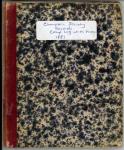by Catherine Schmitt
Creation of the Champlain Society

Champlain Society, Mount Desert Island, 1881
Mount Desert Island Historical Society
The origins of conservation on Mount Desert Island can be traced to a clear, cold night in March 1880, when Harvard student Charles Eliot gathered six of his friends together in 34 Grays Hall in Cambridge to discuss a camping expedition to Maine. With his father, Harvard President Charles William Eliot, in Europe, young Charles had use of the family yacht (the Sunshine) and camping gear. The Eliot family had been spending summers in the region since Charles was a young boy. The place was important to him, and he wanted to share the experience with his classmates. Charles was most certainly encouraged by his father, who believed in learning from nature, in the health benefits of outdoor pursuits, and in science education.
A crew consisting of “Captain” Charles Eliot, his younger brother Samuel A. Eliot, Marshall P. Slade, George B. Dunbar, William H. Dunbar, Henry M. Spelman, hired cook William Breyant, and hired boatman Orrin Donnell (of Sullivan, Maine), sailed Downeast from Boston. On July 4 they established “Camp Pemetic” on Wasgatt Cove in Northeast Harbor, just south of where Hadlock Brook empties into Somes Sound. They mowed the grass, and pitched their six canvas tents: a parlor tent, kitchen, pantry, three medium-sized sleeping tents, and one small tent. They made a flagpole, and raised the red, white and blue colors of their club, called the Champlain Society after Samuel de Champlain.
This was not just a vacation, however. Each member of the group would do some work in natural history or science during their time on the island. A bit of science and a reasonable financial contribution seemed a small price to pay to spend the summer amid the spectacular landscape scenery of Mount Desert.
An additional fifteen students and one professor—William Morris Davis—would join them over the course of the summer, arriving via steamship ferry. They each had scientific “specialties,” such as marine invertebrates, meteorology, ichthyology, botany, ornithology, and geology.

Champlain Club camp and yacht log, Mount Desert Island, 1880
Mount Desert Island Historical Society
They spent their days sailing and rowing across Somes Sound and around the islands, swimming in Lower Hadlock Pond, climbing and tramping across the bare summits and through the forest, all the while collecting and observing natural history. Henry Spelman and Charles Townsend of the Ornithology Department collected birds (by shooting them, as was the common practice at the time). Edward L. Rand headed up the Botanical Department. Samuel Eliot documented the meteorology, and Charles Eliot focused on geology. Photographer Marshall Slade documented their activities.

Champlain Society Records and Yacht Log, Mount Desert Island, 1881
Mount Desert Island Historical Society
In their words and actions, the members of the Champlain Society were representative of their era. In the late nineteenth century, science was not as specialized nor as exclusive as it is today. Naturalists mingled with artists and writers; the distinctions between “professional” and “amateur” were fuzzy at best. Pressing plants and other types of natural history collecting, as well as sharing findings from collecting excursions, remained popular among Victorian-era middle and upper classes.
The Champlain Society’s scientific encounters with nature were tinged with rusticism, romance, and poetry, inspired by the view of the sublime in nature promoted by the landscape painters of the Hudson River School and writings of John Ruskin. Magazine and newspaper reporters described the places one could go to experience dramatic scenery, and a developing market of tourist brochures and guidebooks provided instructions to “rusticators” on what to do once they got there. In the case of Mount Desert, the visitor’s itinerary was not that different than it is today: hike to the summit of Cadillac Mountain, view the sheer cliffs of the the island’s eastern shore, and visit the villages of Bar Harbor, Southwest Harbor, and Somesville.
The Logbooks

Champlain Society Camp log, Mount Desert Island, 1881
Mount Desert Island Historical Society
The Champlain Society logbooks, today held by the Mount Desert Island Historical Society and the Gray Herbarium at Harvard University, contain detailed accounts of the expeditions, as well as their collection of rocks, plants, birds, and marine life, weather observations, and social activities. In the evening they played a card game called whist, read novels, analyzed flowers and prepared animal specimens (e.g., stuffed birds), and took notes. They sang songs, wrote poems, lit firecrackers, pranked one another, and entertained the locals. They played baseball and tug of war, and held regattas in Somes Sound. Back in Cambridge during the school year, they got together for meetings, dinners, and to present their scientific work.
The Champlain Society would return to Mount Desert (moving their camp near Asticou at the head of Northeast Harbor in 1882) every summer through 1889, although membership and the extent of scientific work varied over the years. Charles Eliot remained ever their Captain, even as he began to spend more time at his family’s new summer home in Northeast Harbor (which Charles encouraged his father to build), apprentice in the landscape architecture firm of Frederick Law Olmsted, travel through Europe, and open his own landscape architecture business.